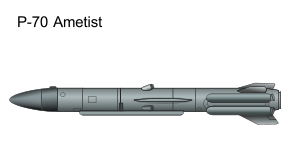P-70 Ametist
The P-70 Ametist (NATO reporting name SS-N-7 Starbright, GRAU designation 4K66; Russian: П-70 «Аметист» 'Amethyst') was an anti-ship missile carried by Soviet and Indian Project 670 submarines, as well as the Soviet Project 661 Anchar. It was soon succeeded by the P-120 Malakhit (SS-N-9 'Siren').
| P-70 Ametist (NATO reporting name: SS-N-7 'Starbright') | |
|---|---|
 | |
| Type | Anti-shipping missile |
| Place of origin | Soviet Union |
| Service history | |
| In service | 1968-1995 |
| Used by | Soviet Union, Russia, India |
| Production history | |
| Manufacturer | NPO Mashinostroyeniye (Chelomei) |
| Specifications | |
| Mass | 7,700 lb (3,500 kg) |
| Length | 23.0 ft (7.0 m) |
| Warhead | high explosive or 200 kiloton nuclear |
| Warhead weight | 1,170 lb (530 kg) |
| Propellant | Solid fuel |
Operational range | 65 km (35 nmi) |
| Maximum speed | Mach 0.9 |
Guidance system | Inertial guidance, terminal active radar homing |
Launch platform | Charlie-I & Papa classes SSGNs |
Development
The P-5 Pyatyorka (SS-N-3 Shaddock) missile required the Project 659 submarines carrying them to spend 30 minutes or more on the surface when firing. This made submarines very vulnerable to enemy attack, so in the 1960s the Soviets started work on a new missile that could be fired whilst submerged, and a submarine to carry it. These became the P-120 Malakhit and Project 670 submarine.
However, problems with the engines of the P-120 Malakhit forced the Soviets to design a sub-launched missile based on the P-15M Termit (SS-N-2C 'Styx') as a stopgap measure for the first batch of Charlie submarines. This became the P-20L, later renamed the P-70 Ametist.
Design
The P-15M was fitted with an L band active radar homing sensor and a new radar altimeter both developed for the P-120, but there was no room for a datalink in the smaller P-15M. Folding wings were added to reduce the size of the missile, and the missile can be launched at a maximum depth of 30 m (98 ft).
The short range of the P-70 meant it did not need mid-course updates from a radar on the submarine, so it could be fired submerged. This more than made up for its lack of range compared to the P-5.
Operational history
The P-70 went into service with the Soviet Navy on the first Project 670, on June 3, 1968.[1] About 200 were produced.
India leased the Chakra, a Soviet Project 670 submarine from January 1988 to 1992, to gain experience of operating a nuclear submarine.
Operators
References
- "P-70 Ametist" (in Russian). Archived from the original on 2011-07-09. Retrieved 2007-01-06.
External links
- MARITIME STRIKE The Soviet Perspective
- www.dtig.org Russian/Sovjet Sea-based Anti-Ship Missiles (pdf)